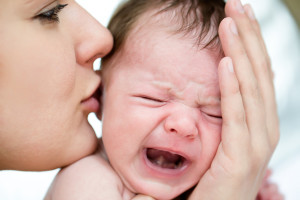
This is the unedited version of an article I wrote for NY Metro Parents last month for their Ask The Expert column – How Can I soothe My Colicky Baby? I was wearing my Happiest Baby Educator hat for this one!
What is “colic?”
“Colic” is a term coined by Dr. Morrison Wessell in 1954 to describe the unexplained and inconsolable crying in an otherwise healthy, well fed baby that occurs for more than three hours a day, three days a week for more than three weeks in the first three months of life. Wessell’s Rule of Three isn’t scientifically based, but is the standard that most pediatricians use when evaluating profoundly fussy infants. Studies suggest that at least one in four babies will exhibit “colicky” behavior during the first three months of life, but the incidence of colic may actually be under reported.
It’s important to note that not all fussy babies are considered colicky babies. Most infants cry for two to three hours per day, but the crying is usually spread out over a 24 hour period. For colicky babies, prolonged episodes of crying can occur at any time, but usually occur at the same time every day – usually late in the day. Colicky babies tend to have shrill, piercing cries that escalate and are often flushed and red in the face. They may pull up their legs, grimace, clench their fists, spit up, and pass gas. Many parents describe their infant as appearing to be in pain, and almost all parents will tell you that during these episodes their babies are virtually impossible to console.
What causes colic?
After over 60 years of research, the cause of colic is still a mystery – there’s no consensus as to why some babies go through this difficult period in the first months of life. The debate over the cause of colic runs the gamut from gastric distress to immature nervous systems to environmental hypersensitivity to challenging temperament. Harvey Karp, a pediatrician and author of The Happiest Baby on the Block has a theory that links colic to the “missing fourth trimester” and the idea that some babies have a difficult time adjusting to the world outside the womb. Most doctors agree that the cause for colicky behavior varies from child to child, and that there is no single scientific explanation for these bouts of intense crying.
What can a parent do to calm a colicky child?
I always recommend that parents check with their pediatrician to rule out any underlying medical conditions or feeding issues that may be contributing to their child’s extreme fussiness. Parents should trust their instincts and find a pediatrician with empathy and an open mind. Although the percentage of effected infants appears to be small, GERD (Gastroesophageal reflux disease), milk protein allergy, oversupply and overfeeding can definitely be the culprit in some cases. It’s important to find a pediatrician who’s willing to explore options and not dismiss parental concerns. For nursing mothers, a certified lactation consultant can be a great resource to help determine if there are feeding issues contributing to their infant’s behavior.
Accumulated stress has also been shown to trigger long bouts of unexplained crying. By six weeks of age, babies are too old to habituate but don’t yet know how to self-soothe, and the result can be intense crying from overstimulation. If parents aren’t doing so already, they should shut down their baby’s world by 6:00 pm or 6:30 pm — most infants are exhausted by early evening and will benefit from being put down to sleep for the night earlier rather than later. I’ve seen nightly meltdowns disappear quickly when parents set a flexible but earlier bedtime and respect their infant’s need for sleep.
The opposite can also be true – some parents report that being under-stimulated appears to contribute to colicky behavior. Although most infants wakeful periods during the day are usually only two hours or less, parents should use that time to feed and offer gentle, stimulating activity. Walks, tummy time, baby massage and face to face time can all lead to less fussing and crying late in the day.
Motion, swaddling, pacifiers, white noise and different holds can also help to reduce crying. Many of my clients have had great success with Harvey Karp’s Cuddle Cure for settling fussy babies – an approach that incorporates all of these basic comforting techniques. Karp believes that re-creating the sensations of the womb by combining “the 5 S’s” (swaddling, side/stomach position, shushing, swinging/jiggling and sucking) triggers what he calls a baby’s “calming reflex”. I’ve seen it bring many infants quickly to a state of calm. Parents can read Karp’s book or seek out a Happiest Baby Educator in their area to show them how to do the 5 S’s. Even babies who only have only occasional bouts of unexplained crying can benefit from his technique.
Although it’s incredibly stressful, parents can take some comfort in the fact that colic passes. It’s also very important to stress to them that being unable to sooth their infant is NOT a reflection on their ability to parent. I urge parents of colicky infants to seek support from others that have lived through it, and to know that it’s OK to take a break – having a grandparent, baby sitter or friend take over occasionally can really make a difference in how they cope during this temporary but trying period.

No comments yet.